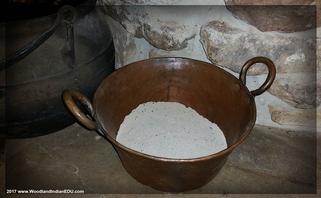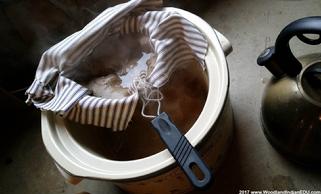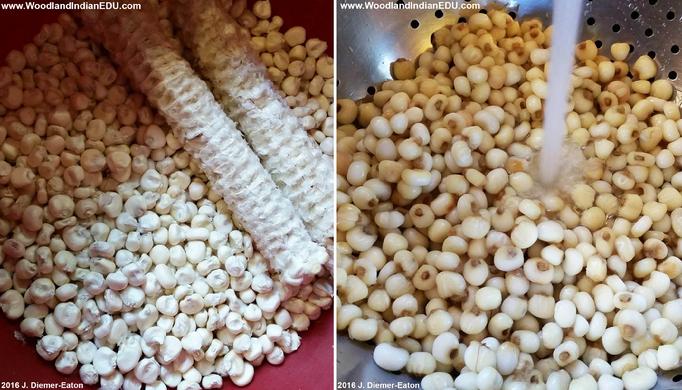Hominy - An Original NATIVE American Dish:
Hominy, a dish attributed to classic Southern American cuisine, is actually an original food of the Native Peoples of the Woodlands region. The word hominy is derived from the Virginia Indian term "rockahominy” possibly referring to corn or parched corn meal. It was shortened to "hominy," creating the popular term we use today. Hominy, or hulled corn, is corn treated with alkali. Here in Eastern North America, that alkali solution was (is) traditionally made of hardwood ash. Indigenous Peoples used lye made of ash water to soften or "burn" the hulls of corn kernels. This treatment is known as nixtamalization. Today most large food producers use sodium hydroxide and other types of lye chemicals in place of ash alkali, and calcium oxide (quicklime) in Mexican-style hominy and tortilla cornmeal... though some Eastern Native cooks and community food producers still make hulled corn/hominy the old way, with ash lye.
---------------
Indigenous Peoples treated their corn (predominantly that of Flint/Eastern 8-Row varieties by AD1200) with alkali for many reasons, most noticeably for taste and texture. The process imparts a pleasant flavor and softens Flint corns - a variety whose name conveys the hardness of this strain. Flint corn was a popular variety among many Eastern Nations... Northern Flint corns being quicker to mature, giving Native farmers the ability to cultivate corn in regions with shorter growing seasons such as the northern of the Great Lakes and New England (such corn was grown as far north as Ontario, Canada by AD800).
---------------
Making corn into hominy also boosts its nutritional value for humans - humans being unable to absorb much of maize's nutrients as is (though technically the process hurts the overall nutritional value of the corn). These Flint corns were in fact hard, as the name suggests... the pericarp being a very hard shell to break down. But treating the corn with lye and softening/slipping the hull made it easier for humans to consume this rather hard corn variety. And the alkali bath helped to release lysine and tryptophan amino acids and hemicellulose-bound niacin (B3) in the corn, presenting more nutrients that could be digested and more fully absorbed when consumed. Lack of niacin in a diet, such as one based mostly on (untreated) corn, can and does lead to diseases like pellagra - a disease caused by a dietary deficiency of niacin, causing complications like disorders of the central nervous system.
|
Corn to Hominy, Hominy to Grits:
The basic process of hominy making in Eastern Native America starts with the alkali... Hardwood ashes were (are) used to make the lye solution. The ashes were mixed with water, or, as sometimes practiced today by Native cooks, water is strained through ash to create a lye with no muddy ash clumps in it. The ash-water/lye solution is then heated with the corn kernels. For some, just heating the mixture was enough to make hominy, while others insisted on beating the corn and ash mixture with pestles to agitate the kernels (often the whole kernels were cracked in this process). After a time, the ash-lye burned away at the hull (loosening it) and swelled the kernels' starchy interior. It also killed the seeds’ germs, which insured the corn would not spoil by sprouting, allowing dried hominy to be stored easier for long periods. The lye water is then discarded, and the hominy rinsed several times to rid it of extra lye residues. A little bit ashes are fine to ingest (might even say it made good seasoning, and in fact some did use a sprinkle of ash in foods for flavor), but large amounts are harmful if consumed. Rinsing was often done with the aid of baskets or plant-fiber bags made for the job of cleaning hominy, accomplished by either pouring water over the hominy-filled sieve or lowering the basket with its contents into the gentle current of a stream or river. The clean hominy could then be prepared for a meal right away, or dried for later use.
|
 |
| Clean hardwood ashes, ready to make a lye from to soak corn in. In one methods, the corn is directly soaked in the water and ash mixture. |
|
|
 |
| The other method was run water through ashes, creating a strong lye water, then soaking corn in the strained lye solution. |
|
|
 |
| The author makes hominy from heritage Miami 8-Row Corn... Left: the corn kernels freshly separated from the cobs, and Right: the finished hominy made from those kernels being rinsed. |
|
|
Hominy/hulled corn was boiled and eaten alone, flavored with animal fat, or combined with other ingredients like beans and pieces of meat. One Cherokee tradition calls for adding hominy to kanuchi – a traditional hickory nut broth still made by some and enjoyed particularly on holidays and at celebrations. Whole hominy can be mashed and eaten as hominy pudding, or baked in cornhusk envelopes, or shaped into patties that were shallow fried in grease (some Native bean bread recipes call for hominy paste as its cornmeal base). Some Southeastern Native dishes, like sofkee, called for ash-treated corn as the main ingredient (more on sofkee coming up in next post). Hominy, dried for later use, could be hydrated and eaten whole... Or the dried hominy could be ground into meal.
-------------
Hominy meal made a Native pudding-like dish we know today as "grits." It's worth noting that grits isn't just coarse ground cornmeal... it's "treated" cornmeal - meal made of hominy (this is the basic texture difference between today's grits and polenta - the former using hominy meal, the second using basic ground cornmeal). Fine hominy meal was used just the same as dry cornmeal in some cornbreads. Meal made of hominy/hulled corn (grits) gave cornmeal dishes a sticky texture that worked well to form cakes... plus a pleasant taste. Such cakes made of hulled-corn meal combined with berries, and cooked by boiling the corn cakes in water, are still made and enjoyed today particularly among Haudenosaunee communities.
|
Sources:
-“Kanuchi” Chreokee Nation Website: http://www.cherokee.org/AboutTheNation/Culture/CookBook/Kanuchi.aspx-“Lenape Indian Cooking” with Touching Leaves Woman (Nora Thompson Dean)-"Natives and Newcomers: The Cultural Origins of North America," by James Axtell
-"Parker on the Iroquois," by Arthur C. Parker
-"Plants from the Past," by Leonard W. Blake and Hugh C. Cutler
-"Societies in Eclipse: Archaeology of the Eastern Woodlands Indians, A.D. 1400-1700," edited by David S. Brose, C. Wesley Cowan, and Robert C. Mainfort Jr.
|
By J. Diemer-Eaton (originally published under Yahoo! Voices in 2011, updated photos added 2018). To cite this article: Diemer-Eaton, Jessica. (2011). Hominy: An Original Native American Dish. Retrieved from http://www.woodlandindianedu.com/hominy.html
|
WIEP Educational Materials Download: Coloring Page about Native Hominy for your Students/Children
|
Click on the image above, or PDF icon to the right, to download the coloring page above. This free downloadable about Native American hominy, is intended for school, homeschool, youth group, or individual use only. This page has been adapted from our book "The First Peoples of Ohio and Indiana."
| 
|
|